Analyzing the Influence of Health Information Technology on Healthcare
VerifiedAdded on 2022/08/11
|8
|1897
|15
Essay
AI Summary
This essay investigates the influence of health information technology (HIT) on clinical decision-making in healthcare, particularly within nursing. It identifies factors that facilitate and inhibit effective clinical decisions, highlighting the importance of a supportive work environment and competent nursing staff. The essay discusses the role of electronic health records (EHRs) and other HIT tools in improving patient care, enhancing efficiency, and reducing medical errors. It also acknowledges potential challenges related to EHR implementation and design. The conclusion emphasizes the critical role of nurses in providing effective patient care and the significance of HIT in supporting their clinical decision-making processes. Desklib provides students with access to a wealth of resources, including past papers and solved assignments.
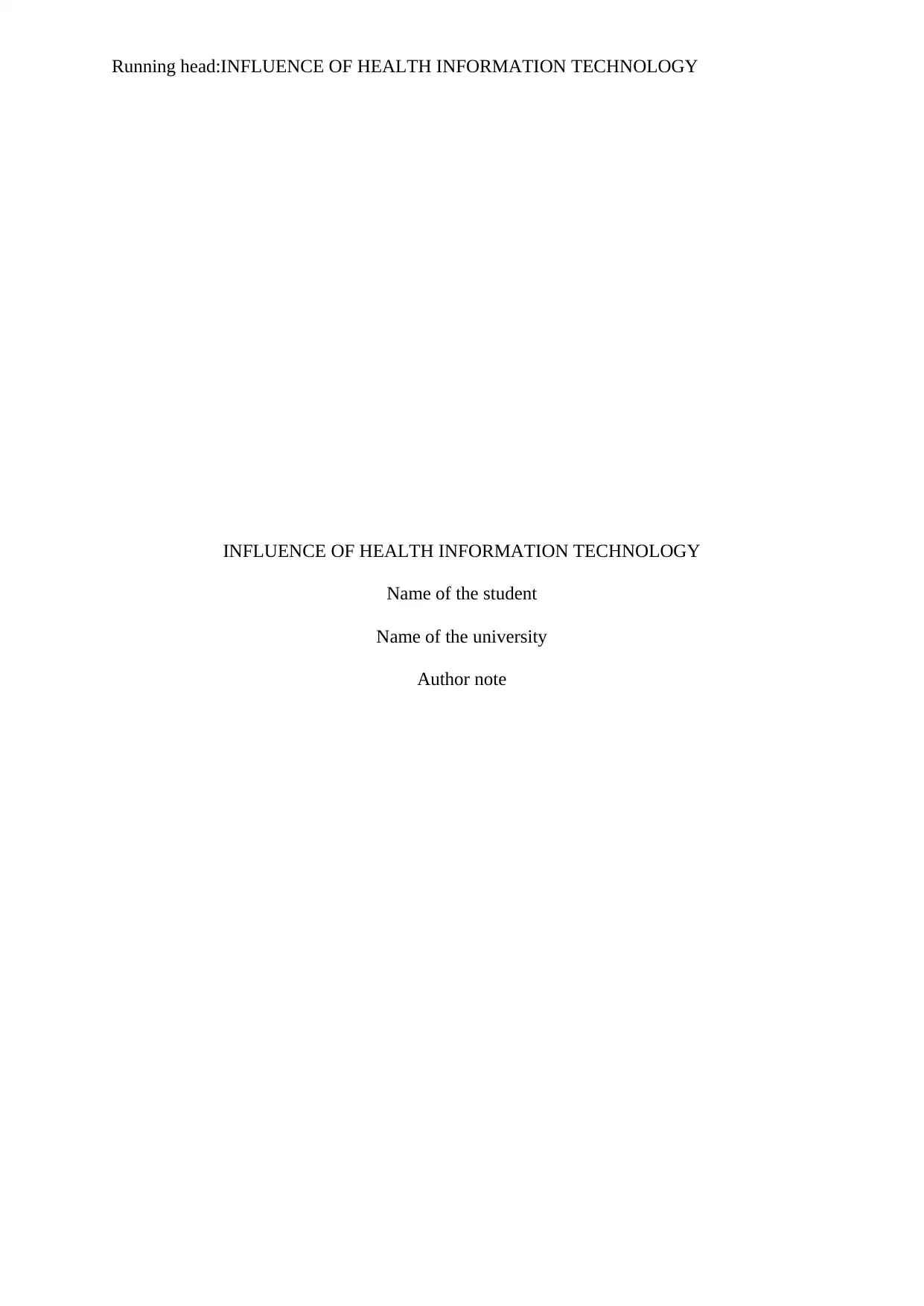
Running head:INFLUENCE OF HEALTH INFORMATION TECHNOLOGY
INFLUENCE OF HEALTH INFORMATION TECHNOLOGY
Name of the student
Name of the university
Author note
INFLUENCE OF HEALTH INFORMATION TECHNOLOGY
Name of the student
Name of the university
Author note
Paraphrase This Document
Need a fresh take? Get an instant paraphrase of this document with our AI Paraphraser
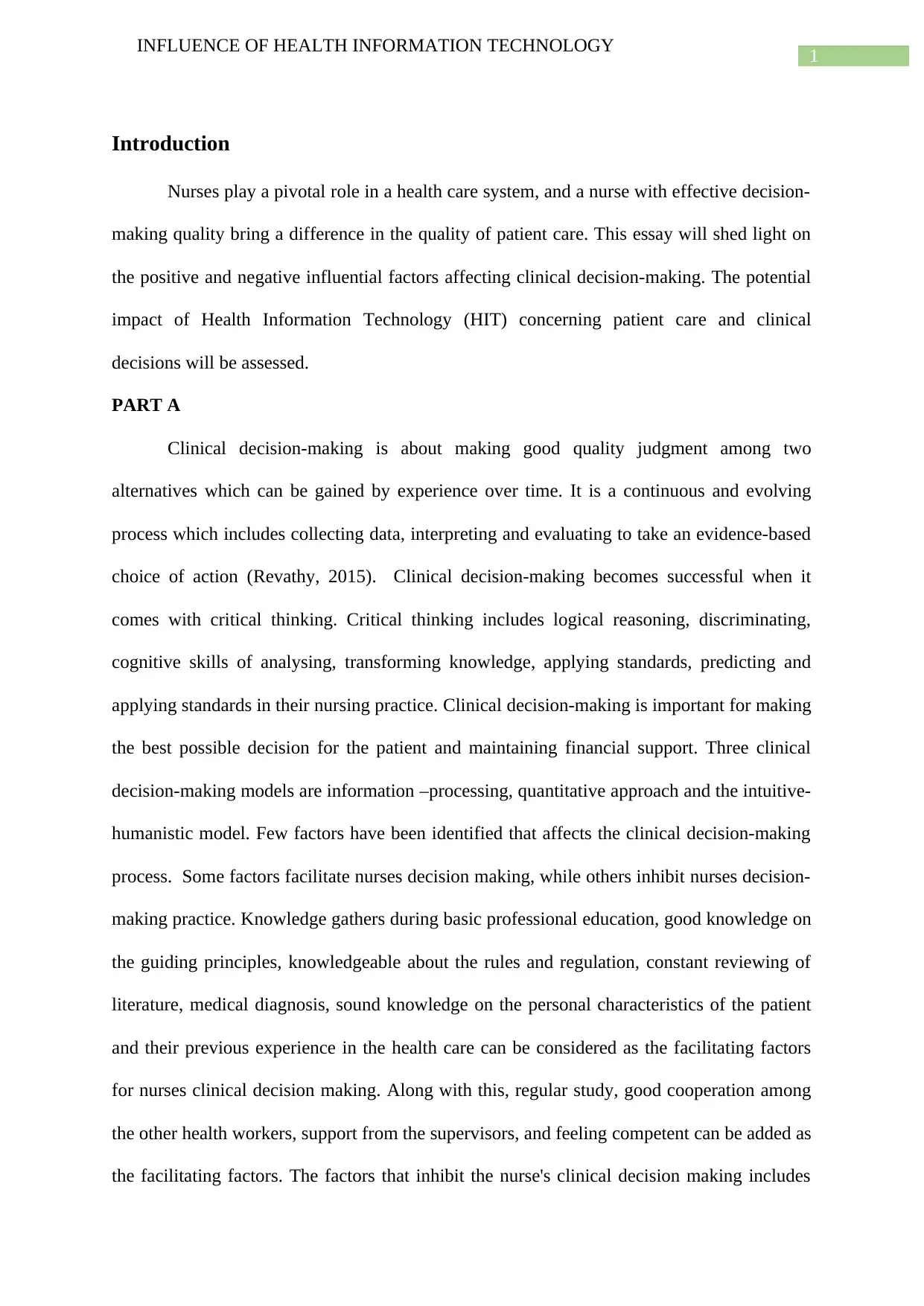
1
INFLUENCE OF HEALTH INFORMATION TECHNOLOGY
Introduction
Nurses play a pivotal role in a health care system, and a nurse with effective decision-
making quality bring a difference in the quality of patient care. This essay will shed light on
the positive and negative influential factors affecting clinical decision-making. The potential
impact of Health Information Technology (HIT) concerning patient care and clinical
decisions will be assessed.
PART A
Clinical decision-making is about making good quality judgment among two
alternatives which can be gained by experience over time. It is a continuous and evolving
process which includes collecting data, interpreting and evaluating to take an evidence-based
choice of action (Revathy, 2015). Clinical decision-making becomes successful when it
comes with critical thinking. Critical thinking includes logical reasoning, discriminating,
cognitive skills of analysing, transforming knowledge, applying standards, predicting and
applying standards in their nursing practice. Clinical decision-making is important for making
the best possible decision for the patient and maintaining financial support. Three clinical
decision-making models are information –processing, quantitative approach and the intuitive-
humanistic model. Few factors have been identified that affects the clinical decision-making
process. Some factors facilitate nurses decision making, while others inhibit nurses decision-
making practice. Knowledge gathers during basic professional education, good knowledge on
the guiding principles, knowledgeable about the rules and regulation, constant reviewing of
literature, medical diagnosis, sound knowledge on the personal characteristics of the patient
and their previous experience in the health care can be considered as the facilitating factors
for nurses clinical decision making. Along with this, regular study, good cooperation among
the other health workers, support from the supervisors, and feeling competent can be added as
the facilitating factors. The factors that inhibit the nurse's clinical decision making includes
INFLUENCE OF HEALTH INFORMATION TECHNOLOGY
Introduction
Nurses play a pivotal role in a health care system, and a nurse with effective decision-
making quality bring a difference in the quality of patient care. This essay will shed light on
the positive and negative influential factors affecting clinical decision-making. The potential
impact of Health Information Technology (HIT) concerning patient care and clinical
decisions will be assessed.
PART A
Clinical decision-making is about making good quality judgment among two
alternatives which can be gained by experience over time. It is a continuous and evolving
process which includes collecting data, interpreting and evaluating to take an evidence-based
choice of action (Revathy, 2015). Clinical decision-making becomes successful when it
comes with critical thinking. Critical thinking includes logical reasoning, discriminating,
cognitive skills of analysing, transforming knowledge, applying standards, predicting and
applying standards in their nursing practice. Clinical decision-making is important for making
the best possible decision for the patient and maintaining financial support. Three clinical
decision-making models are information –processing, quantitative approach and the intuitive-
humanistic model. Few factors have been identified that affects the clinical decision-making
process. Some factors facilitate nurses decision making, while others inhibit nurses decision-
making practice. Knowledge gathers during basic professional education, good knowledge on
the guiding principles, knowledgeable about the rules and regulation, constant reviewing of
literature, medical diagnosis, sound knowledge on the personal characteristics of the patient
and their previous experience in the health care can be considered as the facilitating factors
for nurses clinical decision making. Along with this, regular study, good cooperation among
the other health workers, support from the supervisors, and feeling competent can be added as
the facilitating factors. The factors that inhibit the nurse's clinical decision making includes

2
INFLUENCE OF HEALTH INFORMATION TECHNOLOGY
the previous experience of the nurses, the environment of the healthcare, the attitude of the
staffs, hospital policy, level of self-confidence, time constraints and outcome of the nurse's
decision. After a critical analysis, five main themes have been selected as the prime factors
that help in making an effective clinical decision. The five themes are as follows:
Feeling competent
Being self-confident
Structure of the organization
Support from supervisors
Educating nurses
In the work environment getting support from the supervisors or other nurses is highly
important to cross the barrier and make effective clinical decisions. The support experience is
sub-categorized in three parts: provision of care, provision of emotional support and
provision of financial welfare. However, when being unsupported predominated in the work
culture, it becomes difficult to deliver effective clinical decision making. Lack of support to
the nurses by the managers lowers down their morality, and it is evident to feel frustrated
when the decision is not acknowledged. It is believed that managers are in charge of the
provision of financial welfare for the nurses. This leads to lack of concentration of nurses on
patient's problem, and thus they fail to make effective decisions. Managers are also
responsible for the provision of care facility, which is not achieved by them; thus, lack of care
facility act as a barrier to clinical decision making. Minimum care is provided to the patients
as the nurses fail to meet the patient's needs. Lacks of legal support, emotional support, and
interpersonal support are also the reason behind ineffective decision-making. In addition to
this, the doctors and the managers do not care about the nurse's decision due to which
reluctance is seen among the nurses, and this fails to deliver effective decisions (Shaban,
2015).
INFLUENCE OF HEALTH INFORMATION TECHNOLOGY
the previous experience of the nurses, the environment of the healthcare, the attitude of the
staffs, hospital policy, level of self-confidence, time constraints and outcome of the nurse's
decision. After a critical analysis, five main themes have been selected as the prime factors
that help in making an effective clinical decision. The five themes are as follows:
Feeling competent
Being self-confident
Structure of the organization
Support from supervisors
Educating nurses
In the work environment getting support from the supervisors or other nurses is highly
important to cross the barrier and make effective clinical decisions. The support experience is
sub-categorized in three parts: provision of care, provision of emotional support and
provision of financial welfare. However, when being unsupported predominated in the work
culture, it becomes difficult to deliver effective clinical decision making. Lack of support to
the nurses by the managers lowers down their morality, and it is evident to feel frustrated
when the decision is not acknowledged. It is believed that managers are in charge of the
provision of financial welfare for the nurses. This leads to lack of concentration of nurses on
patient's problem, and thus they fail to make effective decisions. Managers are also
responsible for the provision of care facility, which is not achieved by them; thus, lack of care
facility act as a barrier to clinical decision making. Minimum care is provided to the patients
as the nurses fail to meet the patient's needs. Lacks of legal support, emotional support, and
interpersonal support are also the reason behind ineffective decision-making. In addition to
this, the doctors and the managers do not care about the nurse's decision due to which
reluctance is seen among the nurses, and this fails to deliver effective decisions (Shaban,
2015).
⊘ This is a preview!⊘
Do you want full access?
Subscribe today to unlock all pages.

Trusted by 1+ million students worldwide
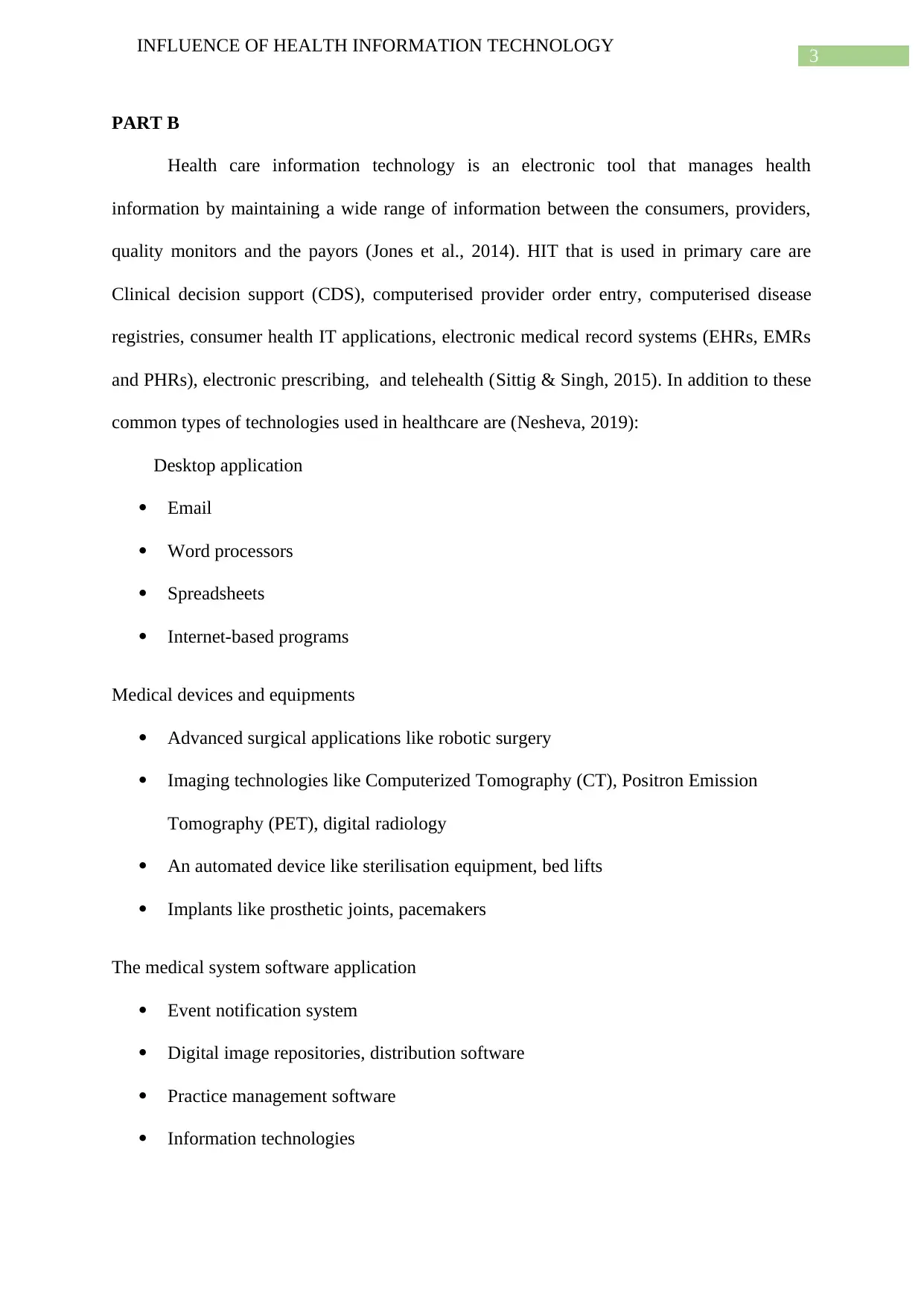
3
INFLUENCE OF HEALTH INFORMATION TECHNOLOGY
PART B
Health care information technology is an electronic tool that manages health
information by maintaining a wide range of information between the consumers, providers,
quality monitors and the payors (Jones et al., 2014). HIT that is used in primary care are
Clinical decision support (CDS), computerised provider order entry, computerised disease
registries, consumer health IT applications, electronic medical record systems (EHRs, EMRs
and PHRs), electronic prescribing, and telehealth (Sittig & Singh, 2015). In addition to these
common types of technologies used in healthcare are (Nesheva, 2019):
Desktop application
Email
Word processors
Spreadsheets
Internet-based programs
Medical devices and equipments
Advanced surgical applications like robotic surgery
Imaging technologies like Computerized Tomography (CT), Positron Emission
Tomography (PET), digital radiology
An automated device like sterilisation equipment, bed lifts
Implants like prosthetic joints, pacemakers
The medical system software application
Event notification system
Digital image repositories, distribution software
Practice management software
Information technologies
INFLUENCE OF HEALTH INFORMATION TECHNOLOGY
PART B
Health care information technology is an electronic tool that manages health
information by maintaining a wide range of information between the consumers, providers,
quality monitors and the payors (Jones et al., 2014). HIT that is used in primary care are
Clinical decision support (CDS), computerised provider order entry, computerised disease
registries, consumer health IT applications, electronic medical record systems (EHRs, EMRs
and PHRs), electronic prescribing, and telehealth (Sittig & Singh, 2015). In addition to these
common types of technologies used in healthcare are (Nesheva, 2019):
Desktop application
Word processors
Spreadsheets
Internet-based programs
Medical devices and equipments
Advanced surgical applications like robotic surgery
Imaging technologies like Computerized Tomography (CT), Positron Emission
Tomography (PET), digital radiology
An automated device like sterilisation equipment, bed lifts
Implants like prosthetic joints, pacemakers
The medical system software application
Event notification system
Digital image repositories, distribution software
Practice management software
Information technologies
Paraphrase This Document
Need a fresh take? Get an instant paraphrase of this document with our AI Paraphraser
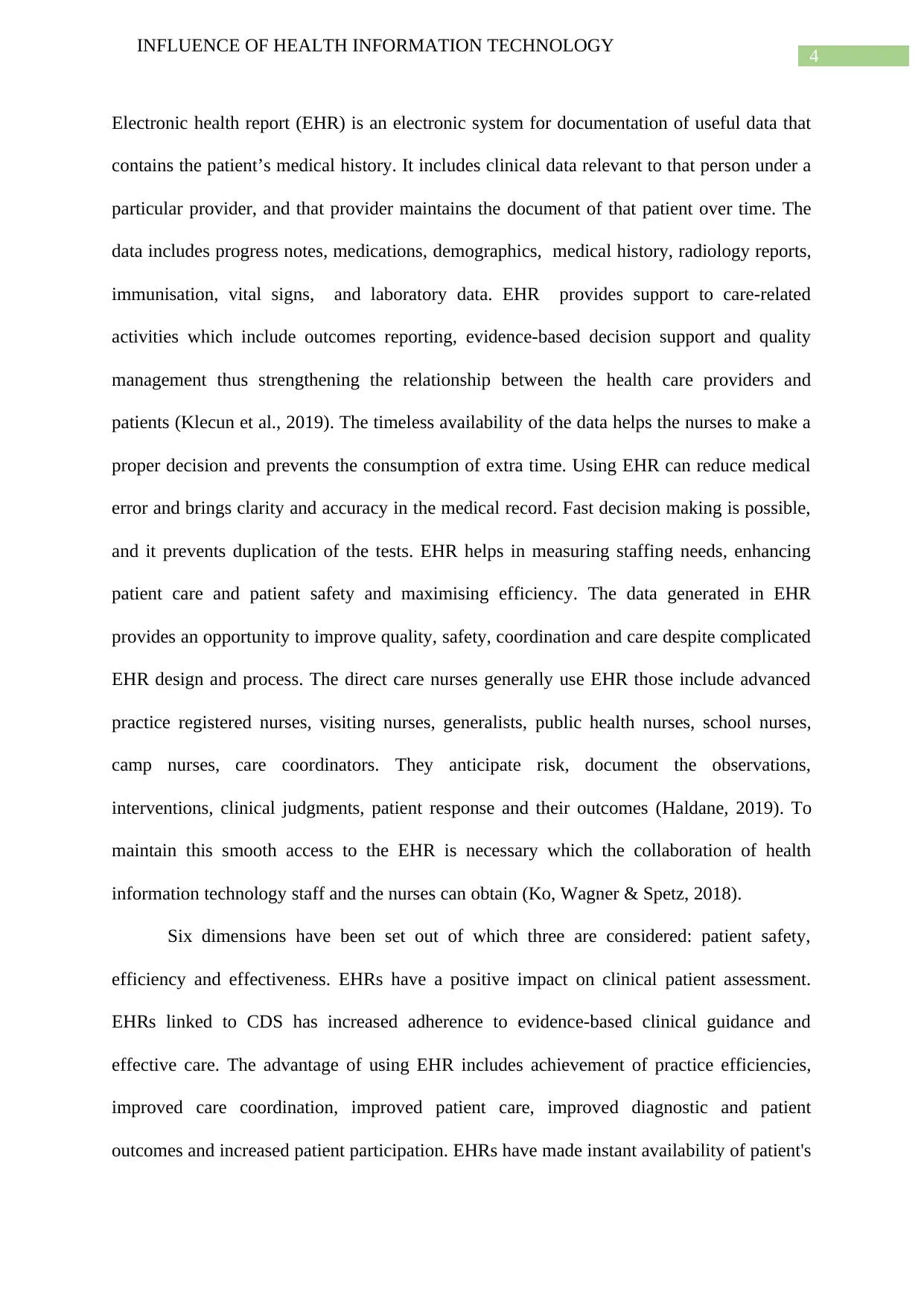
4
INFLUENCE OF HEALTH INFORMATION TECHNOLOGY
Electronic health report (EHR) is an electronic system for documentation of useful data that
contains the patient’s medical history. It includes clinical data relevant to that person under a
particular provider, and that provider maintains the document of that patient over time. The
data includes progress notes, medications, demographics, medical history, radiology reports,
immunisation, vital signs, and laboratory data. EHR provides support to care-related
activities which include outcomes reporting, evidence-based decision support and quality
management thus strengthening the relationship between the health care providers and
patients (Klecun et al., 2019). The timeless availability of the data helps the nurses to make a
proper decision and prevents the consumption of extra time. Using EHR can reduce medical
error and brings clarity and accuracy in the medical record. Fast decision making is possible,
and it prevents duplication of the tests. EHR helps in measuring staffing needs, enhancing
patient care and patient safety and maximising efficiency. The data generated in EHR
provides an opportunity to improve quality, safety, coordination and care despite complicated
EHR design and process. The direct care nurses generally use EHR those include advanced
practice registered nurses, visiting nurses, generalists, public health nurses, school nurses,
camp nurses, care coordinators. They anticipate risk, document the observations,
interventions, clinical judgments, patient response and their outcomes (Haldane, 2019). To
maintain this smooth access to the EHR is necessary which the collaboration of health
information technology staff and the nurses can obtain (Ko, Wagner & Spetz, 2018).
Six dimensions have been set out of which three are considered: patient safety,
efficiency and effectiveness. EHRs have a positive impact on clinical patient assessment.
EHRs linked to CDS has increased adherence to evidence-based clinical guidance and
effective care. The advantage of using EHR includes achievement of practice efficiencies,
improved care coordination, improved patient care, improved diagnostic and patient
outcomes and increased patient participation. EHRs have made instant availability of patient's
INFLUENCE OF HEALTH INFORMATION TECHNOLOGY
Electronic health report (EHR) is an electronic system for documentation of useful data that
contains the patient’s medical history. It includes clinical data relevant to that person under a
particular provider, and that provider maintains the document of that patient over time. The
data includes progress notes, medications, demographics, medical history, radiology reports,
immunisation, vital signs, and laboratory data. EHR provides support to care-related
activities which include outcomes reporting, evidence-based decision support and quality
management thus strengthening the relationship between the health care providers and
patients (Klecun et al., 2019). The timeless availability of the data helps the nurses to make a
proper decision and prevents the consumption of extra time. Using EHR can reduce medical
error and brings clarity and accuracy in the medical record. Fast decision making is possible,
and it prevents duplication of the tests. EHR helps in measuring staffing needs, enhancing
patient care and patient safety and maximising efficiency. The data generated in EHR
provides an opportunity to improve quality, safety, coordination and care despite complicated
EHR design and process. The direct care nurses generally use EHR those include advanced
practice registered nurses, visiting nurses, generalists, public health nurses, school nurses,
camp nurses, care coordinators. They anticipate risk, document the observations,
interventions, clinical judgments, patient response and their outcomes (Haldane, 2019). To
maintain this smooth access to the EHR is necessary which the collaboration of health
information technology staff and the nurses can obtain (Ko, Wagner & Spetz, 2018).
Six dimensions have been set out of which three are considered: patient safety,
efficiency and effectiveness. EHRs have a positive impact on clinical patient assessment.
EHRs linked to CDS has increased adherence to evidence-based clinical guidance and
effective care. The advantage of using EHR includes achievement of practice efficiencies,
improved care coordination, improved patient care, improved diagnostic and patient
outcomes and increased patient participation. EHRs have made instant availability of patient's
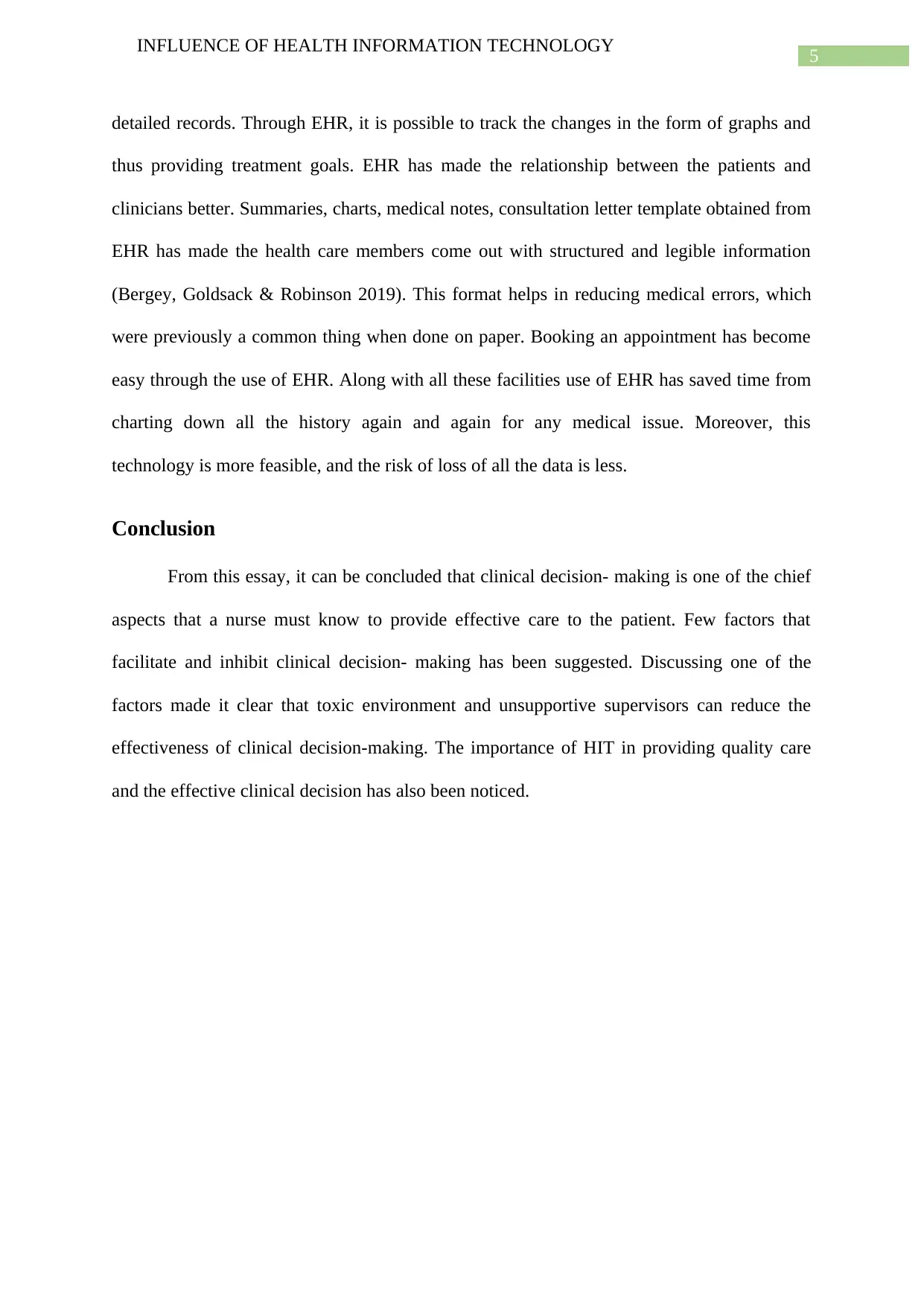
5
INFLUENCE OF HEALTH INFORMATION TECHNOLOGY
detailed records. Through EHR, it is possible to track the changes in the form of graphs and
thus providing treatment goals. EHR has made the relationship between the patients and
clinicians better. Summaries, charts, medical notes, consultation letter template obtained from
EHR has made the health care members come out with structured and legible information
(Bergey, Goldsack & Robinson 2019). This format helps in reducing medical errors, which
were previously a common thing when done on paper. Booking an appointment has become
easy through the use of EHR. Along with all these facilities use of EHR has saved time from
charting down all the history again and again for any medical issue. Moreover, this
technology is more feasible, and the risk of loss of all the data is less.
Conclusion
From this essay, it can be concluded that clinical decision- making is one of the chief
aspects that a nurse must know to provide effective care to the patient. Few factors that
facilitate and inhibit clinical decision- making has been suggested. Discussing one of the
factors made it clear that toxic environment and unsupportive supervisors can reduce the
effectiveness of clinical decision-making. The importance of HIT in providing quality care
and the effective clinical decision has also been noticed.
INFLUENCE OF HEALTH INFORMATION TECHNOLOGY
detailed records. Through EHR, it is possible to track the changes in the form of graphs and
thus providing treatment goals. EHR has made the relationship between the patients and
clinicians better. Summaries, charts, medical notes, consultation letter template obtained from
EHR has made the health care members come out with structured and legible information
(Bergey, Goldsack & Robinson 2019). This format helps in reducing medical errors, which
were previously a common thing when done on paper. Booking an appointment has become
easy through the use of EHR. Along with all these facilities use of EHR has saved time from
charting down all the history again and again for any medical issue. Moreover, this
technology is more feasible, and the risk of loss of all the data is less.
Conclusion
From this essay, it can be concluded that clinical decision- making is one of the chief
aspects that a nurse must know to provide effective care to the patient. Few factors that
facilitate and inhibit clinical decision- making has been suggested. Discussing one of the
factors made it clear that toxic environment and unsupportive supervisors can reduce the
effectiveness of clinical decision-making. The importance of HIT in providing quality care
and the effective clinical decision has also been noticed.
⊘ This is a preview!⊘
Do you want full access?
Subscribe today to unlock all pages.

Trusted by 1+ million students worldwide

6
INFLUENCE OF HEALTH INFORMATION TECHNOLOGY
Reference
Bergey, M. R., Goldsack, J. C., & Robinson, E. J. (2019). Invisible work and changing roles:
Health information technology implementation and reorganization of work practices
for the inpatient nursing team. Social Science & Medicine, 235, 112387.
Haldane, V., Tan, Y. G., Teo, K. W. Q., Koh, J. J. K., Srivastava, A., Cheng, R. X., ... &
Müller-Riemenschneider, F. (2019). Perspectives on Acceptance and Use of a Mobile
Health Intervention for the Prevention of Atherosclerotic Cardiovascular Disease in
Singapore: Mixed-Methods Study. JMIR mHealth and uHealth, 7(3), e11108.
Jones, S. S., Rudin, R. S., Perry, T., & Shekelle, P. G. (2014). Health information technology:
an updated systematic review with a focus on meaningful use. Annals of internal
medicine, 160(1), 48-54.
Klecun, E., Zhou, Y., Kankanhalli, A., Wee, Y. H., & Hibberd, R. (2019). The dynamics of
institutional pressures and stakeholder behavior in national electronic health record
implementations: A tale of two countries. Journal of Information Technology, 34(4),
292-332.
Ko, M., Wagner, L., & Spetz, J. (2018). Nursing home implementation of health information
technology: Review of the literature finds inadequate investment in preparation,
infrastructure, and training. INQUIRY: The Journal of Health Care Organization,
Provision, and Financing, 55, 0046958018778902.
Nesheva, D. (2019, October). Introduction to Health Information Technologies. In IOP
Conference Series: Materials Science and Engineering (Vol. 618, No. 1, p. 012033).
IOP Publishing.
Revathy, U. (2015). Clinical decision making in nursing care: Evidence based practice and
seniority. International Journal for Quality Research, 9(1), 77-88.
INFLUENCE OF HEALTH INFORMATION TECHNOLOGY
Reference
Bergey, M. R., Goldsack, J. C., & Robinson, E. J. (2019). Invisible work and changing roles:
Health information technology implementation and reorganization of work practices
for the inpatient nursing team. Social Science & Medicine, 235, 112387.
Haldane, V., Tan, Y. G., Teo, K. W. Q., Koh, J. J. K., Srivastava, A., Cheng, R. X., ... &
Müller-Riemenschneider, F. (2019). Perspectives on Acceptance and Use of a Mobile
Health Intervention for the Prevention of Atherosclerotic Cardiovascular Disease in
Singapore: Mixed-Methods Study. JMIR mHealth and uHealth, 7(3), e11108.
Jones, S. S., Rudin, R. S., Perry, T., & Shekelle, P. G. (2014). Health information technology:
an updated systematic review with a focus on meaningful use. Annals of internal
medicine, 160(1), 48-54.
Klecun, E., Zhou, Y., Kankanhalli, A., Wee, Y. H., & Hibberd, R. (2019). The dynamics of
institutional pressures and stakeholder behavior in national electronic health record
implementations: A tale of two countries. Journal of Information Technology, 34(4),
292-332.
Ko, M., Wagner, L., & Spetz, J. (2018). Nursing home implementation of health information
technology: Review of the literature finds inadequate investment in preparation,
infrastructure, and training. INQUIRY: The Journal of Health Care Organization,
Provision, and Financing, 55, 0046958018778902.
Nesheva, D. (2019, October). Introduction to Health Information Technologies. In IOP
Conference Series: Materials Science and Engineering (Vol. 618, No. 1, p. 012033).
IOP Publishing.
Revathy, U. (2015). Clinical decision making in nursing care: Evidence based practice and
seniority. International Journal for Quality Research, 9(1), 77-88.
Paraphrase This Document
Need a fresh take? Get an instant paraphrase of this document with our AI Paraphraser

7
INFLUENCE OF HEALTH INFORMATION TECHNOLOGY
Shaban, R. (2015). Theories of clinical judgment and decision-making: A review of the
theoretical literature. Australasian Journal of Paramedicine, 3(1).
Sittig, D. F., & Singh, H. (2015). A new socio-technical model for studying health
information technology in complex adaptive healthcare systems. In Cognitive
informatics for biomedicine (pp. 59-80). Springer, Cham.
INFLUENCE OF HEALTH INFORMATION TECHNOLOGY
Shaban, R. (2015). Theories of clinical judgment and decision-making: A review of the
theoretical literature. Australasian Journal of Paramedicine, 3(1).
Sittig, D. F., & Singh, H. (2015). A new socio-technical model for studying health
information technology in complex adaptive healthcare systems. In Cognitive
informatics for biomedicine (pp. 59-80). Springer, Cham.
1 out of 8
Related Documents
Your All-in-One AI-Powered Toolkit for Academic Success.
+13062052269
info@desklib.com
Available 24*7 on WhatsApp / Email
![[object Object]](/_next/static/media/star-bottom.7253800d.svg)
Unlock your academic potential
Copyright © 2020–2025 A2Z Services. All Rights Reserved. Developed and managed by ZUCOL.





